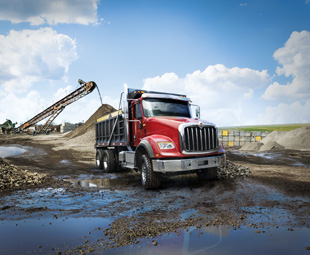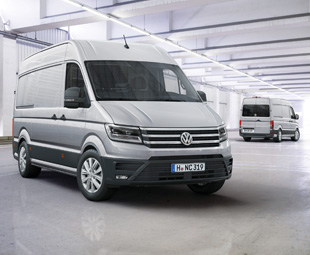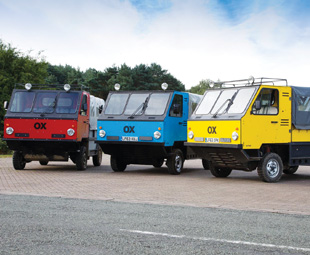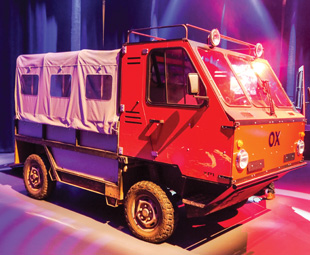Volkswagen and Navistar: The deal is ON!

In his monthly review of global news for local truckers, FRANK BEETON confirms that the much-rumoured relationship between Volkswagen (VW) and Navistar is finally materialising and ponders on some follow-up moves. He discusses some interesting differences in VW’s new stand-alone Crafter integral van, and describes an unusual multi-purpose vehicle for emerging markets designed by a Formula One icon
Yes, you read it here first! It was back in 2012 that we first mentioned reports that Volkswagen AG was showing interest in Navistar International, in an apparent effort to gain access to the North American heavy-duty truck market.
At the time, VW was rolling out its strategy for global motor industry leadership and, recognising that its Scania and MAN truck operations did not have a substantial presence in that market, or access to the conventional (bonneted) models that would be necessary to make any realistic inroads, the prospect of acquiring Navistar had obvious attractions.
Since then, VW has had to confront its diesel emissions scandal, which is still receiving attention in the global media on a regular basis. Notwithstanding that enormous challenge, the group’s latest long-term corporate strategy, revealed in June, included the goal of making VW’s Truck & Bus subsidiary “the most profitable company in the sector, with a significant presence in all key regions of the globe”.
This latter element made the aforementioned presence in North America of cardinal importance, so the announcement, on September 6, that VW Truck & Bus had agreed to acquire a 16,6 percent stake in Navistar International Corporation, at a cost of approximately $US 256 million (R3,65 billion), was a fairly predictable development.
Overcoming obstacles
Previously, we had pointed out that Navistar’s recently concluded cooperation agreements with General Motors, and the United States (US) government’s possible opposition to this supplier of military equipment coming under foreign control may have presented obstacles to a possible deal, but it is unlikely that these issues will become material unless VW moves to substantially increase its shareholding.
As it stands, the alliance to be formed will encompass strategic technology and supply cooperation, as well as a procurement joint venture. Specific mention has been made of powertrain collaboration, and this is important given that Navistar has a historical link with MAN through a 2008 licensing agreement, which enabled the building of 11 and 13-litre diesel engines in North America for its truck range.
However, when considering Navistar’s position, it is important to remember that it also has a significant presence in the lighter-payload segments of the North American market, in school bus manufacture, and as a leading global manufacturer of diesel engines.
The Navistar Engine Group also includes the South American diesel-engine manufacturing concern MWM International, which supplies power units to a number of prominent original equipment vehicle and equipment manufacturers.
These include VW Caminhoes e Onibus in Brazil. As mentioned previously, it is also a major supplier of vehicles and power units to the US military. It is not clear, at this stage, if any of these operations will be drawn into the VW-Navistar alliance.
Ripe for the picking
Regular readers of Global Focus have been kept fully informed on developments at Navistar since this column’s inception at the beginning of 2006.
Issues that we have covered include the
termination of the company’s long-running arrangement with the Ford Motor Company to supply diesel engines for the F-Series Super Duty pickups and van models.
We have also discussed the ill-starred NC²-branded “global” cooperation with Caterpillar, which promised so much but just faded away, as well as the much-vaunted, but subsequently terminated Indian joint venture with Mahindra & Mahindra, which, at one time, seemed destined to have a direct impact on Navistar’s presence in the South African market.
Many of Navistar’s recent problems stemmed from issues relating to the non-compliance of certain of its diesel engines with the EPA2010 emissions standards. These necessitated emergency countermeasures to keep Navistar International alive as a truck manufacturer in its home North American market.
That episode put a huge strain on the company’s resources, which resulted in it abandoning its expansionist global strategy and concentrating rather on corporate survival.
Since then, there has been more positive news, headed up by the engine and technology arrangements with Cummins, which provided valuable breathing space and the aforementioned supply and production agreements with General Motors.
Just the beginning?
Some observers have heralded news of VW’s buy-in as a financial rescue for Navistar. We can certainly see the benefits that will accrue to the German group from the association in the form of a ready-made North American product range, manufacturing base and distribution/product support structure.
Somehow, we don’t think that a 16,6 percent shareholding will provide VW with the leverage that it desires over such a potentially important asset, and we are sure that the ownership ratio will be expanded. We would also not be surprised if VW’s interests stretch beyond the truck manufacturing and marketing arenas to encompass other areas of Navistar’s business.
On the other side, we think that Navistar International’s export footprint in the global truck business is unlikely to be expanded beyond some limited sales of US-type conventional models in Australia. The prospects for a revival, or replacement, of the forward-control 9800 Eagle series, which was formerly very successful in South Africa, seem very slim indeed.
After all, both MAN and Scania have comprehensive ranges of suitable products for this market, so we don’t see any point in creating additional in-family competition in a market that is currently contracting.
There would, of course, be opportunities for “badge engineering”, but this is only likely to be considered in markets which are large enough to accommodate multiple parallel distribution strategies.
We certainly don’t think that this deal will fully satisfy VW’s appetite for acquisitions or joint ventures in important markets where it is absent or under-represented. We were particularly interested in talks held with Isuzu Motors in 2011 covering “pickup trucks, diesel engines and larger trucks”.
We have frequently commented on the desirability of Isuzu forming global partnerships to strengthen its participation at the upper end of the payload spectrum. Isuzu’s current relationship with General Motors is important, but tends to be fragmented and variable, and the Japanese manufacturer recently entered a new alliance with Russian manufacturer GAZ. It also concluded a pickup supply agreement with Mazda.
We believe that Isuzu would benefit greatly from a more inclusive global relationship, and that it would bring multiple quality inputs to the party, including a particularly strong global position in diesel engines and light-medium trucks and an extensive Asian footprint.
The present relationship with GM and the small Toyota shareholding in Isuzu may present as obstacles, but, in our view, nothing that a big fistful of Euros couldn’t dislodge!
NEW CRAFTER STANDS ALONE!
VW is really hogging the headlines this month, and this particular story has run for nearly as long as the preceding saga.
It was back in 2013 that we first became aware that Volkswagen AG and Daimler AG were planning to end their highly successful cooperative “heavy van” building partnership, which had run continuously since 1995 and produced millions of Sprinters and Crafters.
Now, in the second half of 2016, we have reached the identified target date for product separation, and VW’s new stand-alone Crafter – which is to be produced at a new 220-hectare plant located at Września, in Poland – has emerged.
Much the same, but very different!
 Appearance-wise, the new Crafter does not differ radically from its predecessor, which is understandable in a class of vehicles where function largely dictates form. However, the frontal styling is somewhat softer and definitely generic VW, with a less obvious “snout” than the previous generation Crafter.
Appearance-wise, the new Crafter does not differ radically from its predecessor, which is understandable in a class of vehicles where function largely dictates form. However, the frontal styling is somewhat softer and definitely generic VW, with a less obvious “snout” than the previous generation Crafter.
Remarkably, the front-wheel-drive 4×2, and all-wheel-drive versions of the new model have a transversely mounted 2,0-litre diesel engine, while the rear-wheel drive 4×2 derivatives have a longitudinally mounted engine!
We can only imagine that this remarkable spectrum of driveline configurations has been made possible by some highly creative chassis design, or at least two different floor plans for transverse and longitudinal engine variants. The east/west-located engines are also inclined eight degrees forward, to provide greater cab space.
(See page 12 for details on the electric version, the e-Crafter, launched at the IAA – ed.)
Euro-6 engine outputs range from 75 kW (102 hp) to 130 kW (177 hp), driving through a choice of manual or automatic transmissions. In the launch publicity, VW talks of “a maximum payload of 5,5 t”, but we suspect that this is actually the top gross vehicle mass rating, to match competitive European vans.
The front suspension is by McPherson struts, with five available parabolic-sprung rigid rear axle layouts, and the power steering incorporates an innovative electromechanical system. Driver convenience and comfort are enhanced by an optional ergonomic suspension seat, electric windows and remote-controlled central locking.
Safety and convenience features include lane-keeping assist, parking assistant, trailer manoeuvring assistance, adaptive cruise control, emergency braking, side wind assist, adaptive headlight dipping, reversing camera, and sensor-based side protection.
The new Crafter range includes no less than 69 derivatives, with van lengths of 5 986 mm, 6 836 mm
or 7 391 mm, with three height options ranging from 2 355 mm to 2 798 mm, as well as Kombi people-mover and single- or double-cab chassis/cab variants for specialised bodywork fitment.
The design includes numerous features to facilitate the loading and securing of payloads. Application-specific options include a second compressor, a second battery, a second air-conditioner, a separate heat exchanger, and a telematics-enabled fleet management interface.
The new Crafter order book will be opened in November, 2016, and a right-hand-drive version for the United Kingdom market is expected in the second quarter of 2017.
Crafter opening up new horizons?
It is clear that VW Commercial Vehicles has put a huge amount of effort into the creation of its own “heavy van”, and it will be very interesting to see how Mercedes-Benz responds when the next-generation Sprinter emerges. We have found the evolution of VW as a major player in the global commercial vehicle business since 2000 to be most absorbing.
This unexpected change in strategic direction started when VW purchased a stake in Swedish heavy truck and bus manufacturer Scania. Global Focus has fully covered the subsequent roll-out of the strategy right up to the acquisition of Navistar shares covered earlier, so we will not repeat the full story here.
However, we are still a little puzzled by the exclusion of VW Commercial Vehicles from the newly formed Truck and Bus division, particularly as the Crafter and the recently announced MAN van spinoff fit so naturally into the lower strata of the truck business. Maybe this situation will change later as the strategy rolls out.
The other interesting point is the possibility that the new Crafter will, like so many other European vans, migrate across the North Atlantic. VW clearly sees North America as a key area for future growth, as evidenced by the Navistar acquisition. The group has, however, suffered a severe setback in that market recently with the “dieselgate” scandal and needs to rebuild its credibility.
The increased emphasis on commercial vehicles may end up as a very handy tool in giving the company something on which to concentrate its efforts while the consequences of the diesel-emissions and fuel-consumption scandal are addressed
GORDON MURRAY’S FLAT-PACK TRUCK
Gordon Murray is a Durban boy, who rose to great heights as a designer of Formula One racing cars and the McLaren F1 supercar. Back in 1968, I had the pleasure of competing against him in a local hill climb, but my slightly modified BMC Mini was no match for his self-built and Lotus 7-inspired IGM clubman’s sports car.
 Nowadays he is known as Professor Gordon Murray and has acted as consultant on a number of revolutionary vehicle designs. This made him a natural choice to become involved in entrepreneur and philanthropist Sir Torquil Norman’s vision to design a cost-effective mobility platform for Africa and the developing world.
Nowadays he is known as Professor Gordon Murray and has acted as consultant on a number of revolutionary vehicle designs. This made him a natural choice to become involved in entrepreneur and philanthropist Sir Torquil Norman’s vision to design a cost-effective mobility platform for Africa and the developing world.
The resulting vehicle, dubbed OX, has been developed under the auspices of the Global Vehicle Trust, and the project has now been launched to the public with the objective of attracting investment and support to industrialise the design, which has already undergone comprehensive prototype testing.
The basic design layout consists of a small forward-control truck with a 1 900 kg payload capability, a three-man cab and a single 16-inch wheel at each corner. The steel ladder chassis carries bodywork manufactured from engineered plywood, and the rack-and-pinion steering is located in the centre of the cab (shades of the McLaren F1!) to overcome any debate over left or right-hand drive.
 It is powered by a 2,2-litre Ford Transit diesel engine, driving the front wheels through a five-speed all synchromesh transmission, and the originators claim that it can equal a four-wheel-drive vehicle across a range of surfaces. The all-independent suspension works through a system of leading and trailing arms, coil springs and telescopic dampers. Disc brakes are fitted front and rear.
It is powered by a 2,2-litre Ford Transit diesel engine, driving the front wheels through a five-speed all synchromesh transmission, and the originators claim that it can equal a four-wheel-drive vehicle across a range of surfaces. The all-independent suspension works through a system of leading and trailing arms, coil springs and telescopic dampers. Disc brakes are fitted front and rear.
One of the more important aspects of the design is its ability to be “flat-packed” within its own chassis frame for ease of shipment and assembly overseas. Six flat-pack units can be transported in a 40-foot, high-cube container. It is claimed that three skilled workers can assemble an OX in approximately 12 hours.
The design also incorporates numerous handy features including a dual-purpose tailgate/loading ramp, and a rear bench seat that can double as a “sand ladder” to be placed under the wheels to improve mobility in soft underfoot conditions.
This is not the first attempt at creating a basic transportation unit for developing markets, and it will certainly not be the last. Older readers may remember the locally-built Chevrolet Nomad pseudo-jeep of the mid-1970s, or Toyota’s TUV “Ugly Truckling” of a decade later.
These projects have generally faded away because their very basic styling turns off potential buyers, who move on to buy more aesthetically attractive second-hand vehicles.
The OX has no pretensions to be anything other than a working vehicle, suitable for areas where ability is more important than appearance, and is considerably larger than the other two products mentioned here, so it has a chance of succeeding if the right backing and marketing become available.
Global FOCUS is a monthly update of international news relating to the commercial vehicle industry. It is compiled exclusively for FOCUS by Frank Beeton of Econometrix.
Published by
Focus on Transport
focusmagsa




